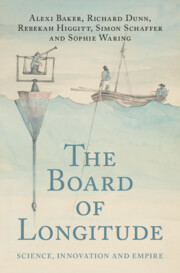Refine search
Actions for selected content:
207 results
Birds may represent a useful animal model for studying human mental disorders
-
- Journal:
- Acta Neuropsychiatrica / Accepted manuscript
- Published online by Cambridge University Press:
- 05 November 2025, pp. 1-32
-
- Article
-
- You have access
- Open access
- Export citation
3 - The Invention of Japan’s Pacific
-
- Book:
- The Kuroshio Frontier
- Published online:
- 11 October 2025
- Print publication:
- 23 October 2025, pp 76-109
-
- Chapter
-
- You have access
- Open access
- HTML
- Export citation
Wayfinding in the Roman City: A Subaltern Spatial Modality
-
- Journal:
- Antichthon , First View
- Published online by Cambridge University Press:
- 16 September 2025, pp. 1-30
-
- Article
- Export citation
Terrain matching without redundant 3D Zernike moments
-
- Journal:
- The Journal of Navigation , First View
- Published online by Cambridge University Press:
- 22 August 2025, pp. 1-11
-
- Article
- Export citation
Probability of active navigational failures: incident analyses for use in ship-bridge allision risk assessments
-
- Journal:
- The Journal of Navigation , First View
- Published online by Cambridge University Press:
- 08 August 2025, pp. 1-19
-
- Article
-
- You have access
- Open access
- HTML
- Export citation
HECATAEUS OF MILETUS FR. 310 JACOBY: A DISPLAY OF COLLECTIVE GREEK IDENTITIES IN EGYPT OR A NAVIGATION MANUAL?
-
- Journal:
- The Classical Quarterly , First View
- Published online by Cambridge University Press:
- 31 July 2025, pp. 1-17
-
- Article
-
- You have access
- Open access
- HTML
- Export citation
19 - Trade in Old Regime Europe
- from Part II - International Law in Old Regime Europe (1660–1775)
-
-
- Book:
- The Cambridge History of International Law
- Published online:
- 22 April 2025
- Print publication:
- 08 May 2025, pp 620-655
-
- Chapter
- Export citation
8 - Trade and Navigation in Renaissance Europe
- from Part I - International Law in Renaissance Europe (1492–1660)
-
-
- Book:
- The Cambridge History of International Law
- Published online:
- 22 April 2025
- Print publication:
- 08 May 2025, pp 263-300
-
- Chapter
- Export citation

Insularity and Identity
- Prehistoric Britain and the Archaeology of Europe
-
- Published online:
- 05 May 2025
- Print publication:
- 29 May 2025
-
- Element
- Export citation
4 - The Early Commissioners in Transition
-
-
- Book:
- The Board of Longitude
- Published online:
- 11 April 2025
- Print publication:
- 17 April 2025, pp 65-88
-
- Chapter
- Export citation
7 - Manufacturing the Nautical Almanac
-
-
- Book:
- The Board of Longitude
- Published online:
- 11 April 2025
- Print publication:
- 17 April 2025, pp 157-191
-
- Chapter
- Export citation
9 - A Practical Institution Weighed Down by Impractical Proposals?
-
-
- Book:
- The Board of Longitude
- Published online:
- 11 April 2025
- Print publication:
- 17 April 2025, pp 210-228
-
- Chapter
- Export citation
3 - Launching the Eighteenth-Century Search for Longitude
-
-
- Book:
- The Board of Longitude
- Published online:
- 11 April 2025
- Print publication:
- 17 April 2025, pp 39-64
-
- Chapter
- Export citation
5 - The Birth of the Board of Longitude
-
-
- Book:
- The Board of Longitude
- Published online:
- 11 April 2025
- Print publication:
- 17 April 2025, pp 89-121
-
- Chapter
- Export citation
2 - Sailing the Oceans and Seeking Longitude before 1714
-
-
- Book:
- The Board of Longitude
- Published online:
- 11 April 2025
- Print publication:
- 17 April 2025, pp 19-38
-
- Chapter
- Export citation
Sailing the Waters of East and Southeast Asia: Chinese Navigators and their Material and Mental Tools
-
- Journal:
- Journal of Chinese History , First View
- Published online by Cambridge University Press:
- 15 April 2025, pp. 1-23
-
- Article
-
- You have access
- Open access
- HTML
- Export citation

The Board of Longitude
- Science, Innovation and Empire
-
- Published online:
- 11 April 2025
- Print publication:
- 17 April 2025
An approach towards mobile robot recovery due to vision sensor failure in vSLAM systems using ROS
-
- Article
-
- You have access
- Open access
- HTML
- Export citation
The Plane Scale and stereographic projection in early navigation
-
- Journal:
- The Journal of Navigation / Volume 78 / Issue 1 / January 2025
- Published online by Cambridge University Press:
- 20 June 2025, pp. 20-36
- Print publication:
- January 2025
-
- Article
- Export citation
